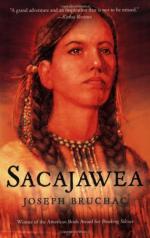|
This section contains 348 words (approx. 1 page at 400 words per page) |

|
Sacajawea Summary & Study Guide Description
Sacajawea Summary & Study Guide includes comprehensive information and analysis to help you understand the book. This study guide contains the following sections:
This detailed literature summary also contains Topics for Discussion on Sacajawea by Joseph Bruchac.
President Thomas Jefferson believed that a successful trans-continental exploration would establish the United States' claim to the largely unknown interior of the continent; spur commercial exploitation of the area; stymie British, French, and Spanish interests in the area; reap a vast benefit of scientific knowledge; discover an all-water route across the continent; make peaceful contact with numerous Indian nations; and, finally, enhance the international prestige of the young nation. He thus authorized governmental expenditure to fund such an expedition. Jefferson appointed Meriwether Lewis to lead what would become known as the Corps of Discovery. Lewis enlisted William Clark, a personal and intimate friend and a prior commanding officer, to act as co-captain on the voyage.
From 1804 to 1805 Lewis and Clark led the Corps of Discovery up the Missouri River, across the Rocky Mountains, and down the Columbia River. They spent the winter in what is present-day Washington State, and then in 1806 returned along largely the same route. Over the entire period the Corps of Discovery suffered only a few serious injuries—no deaths and no permanent disabilities. During 1805 the expedition stayed for several weeks at the Mandan Indian villages where they met and hired Toussaint Charbonneau, a French trapper. Charbonneau was to act as interpreter on the voyage. Charbonneau's wife, the Indian woman Sacajawea, accompanied the expedition because as a Shoshone Indian by birth she was familiar with the terrain, culture, and language of the Shoshone Indians. Over the next year Sacajawea proves of great worth to the expedition, teaching the white men many things about survival in the mountains and securing for them much Indian assistance. Charbonneau proves rather less useful. Sacajawea takes her weeks-old infant, Jean Baptiste Charbonneau, along on the voyage. After the successful completion of the exploration, Charbonneau and Sacajawea move briefly to Saint Louis where they entrust the upbringing and education of their son to the successful Clark. Meanwhile, Lewis descends into depression and eventually takes his own life. The novel is strongly based on historic events and every character appearing in the novel has a historic counterpart.
Read more from the Study Guide
|
This section contains 348 words (approx. 1 page at 400 words per page) |

|



